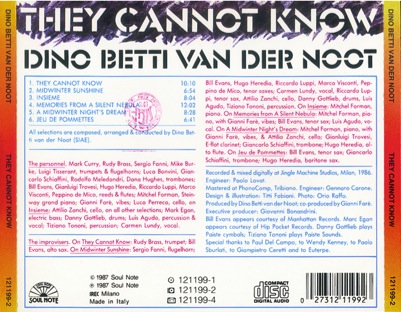
ALBUMS


THEY CANNOT KNOW DINO BETTI VAN DER NOOT
1 They Cannot Know 10:10
2 Midwinter Sunshine 6:54
3 Insieme* 8:04
4 Memories from A Silent Nebula 12:02
5 A Midwinter Night’s Dream 8:28
6 Jeu de Pommettes 6:41
Total playing time 52:19
All selections are composed, arranged and conducted by Dino Betti van der Noot.
Jacket Artwork by Titti Fabiani.
The Improvisers. Luis Agudo, Rudy Brass, Peppino De Mico, Bill Evans, Sergio Fanni, Gianni Farè, Mitchel Forman, Danny Gottlieb, Hugo Heredia, Carmen Lundy, Riccardo Luppi, Giancarlo Schiaffini, Tiziano Tononi, Gianluigi Trovesi, Marco Visconti. Attilio Zanchi.
The Orchestra. Mark Curry, Rudy Brass, Sergio Fanni, Mike Burke, Luigi Tisserant, trumpets & flugelhorns; Luca Bonvini, Giancarlo Schiaffini, Ron Burton, Dana Huges, trombones; Hugo Heredia, Bill Evans, Gianluigi Trovesi, Riccardo Luppi, Marco Visconti, Peppino De Mico, reeds & flutes; Mitchel Forman, Steinway grand piano; Luca Perreca, cello (* only); Attilio Zanchi, cello (all selections except *), Gianni Farè, vibes; Mark Egan, electric bass; Danny Gottlieb, drums; Luis Agudo, percussion & vocal; Tiziano Tononi, percussion; Carmen Lundy, vocal.
Milan, 1986.
Whatever the climate of Betti van der Noot’s compositions, they are narratives rife with color, ranging from the boldest hues to the most subtle. This is consistent with his statement: “I love to change moods, dynamics and tempos within a composition”.
“I like to tell stories”, says Dino, “to show emotional itineraries through my music. I like to write melodies you can remember and unusual chord progressions able to make them more memorable”.
Betti van der Noot is obviously a man of rich imagination. What inspires him? As you will hear it may be the essence of a day, something from his background or that great, universal inspirator, love. A theme may be followed to fruition soon after insinuating itself into his consciousness or gain full life after lying dormant on a page of manuscript for months – or even years. Dino pursues his muses in an unforced manner. There is no writing on demand: Here we have a sensitive, inventive melodist and lapidarian master of orchestral skills, aquired by doing, after studies in Italian music schools, the Berklee College of Music in Boston and from listening to those talents he admired.
The make-up of the orchestra reflects Betti van der Noot’s kaleidoscopic conception of his compositions. “Working with musicians of different origins and styles (here you can find Americans, Italians and Latin Americans) to whom I try to offer a fresh – maybe different – approach to enhance their improvising capabilities.
“The orchestra, finally, is in my opinion something to be mixed and changed continuously, to get the sound I need in any particular moment”.
To this end Dino uses vibes, cello, percussion and the human voice, as well as the conventional sections with liberal use of mutes for the brass, and flutes and clarinets to complement the various members of the saxophone family.
The very name, Dino Betti van der Noot, fascinated me and I asked our main protagonist about the Italian and even more western European derivations. “My family helped to found the city of Brussels”, he explained. “They were quite combative people”.
I suspect that there were a few poets among them.
Ira Gitler
Qualunque sia il clima delle composizioni di Betti van der Noot, sono racconti ricchi di colori, che passano dalle tinte più forti alle più tenui. Questo è in armonia con la sua affermazione: “Amo cambiare atmosfere, dinamiche e tempi all’interno di una composizione”.
“Amo raccontare delle storie”, dice Dino, “creare itinerari emotivi attraverso la mia musica. Amo scrivere melodie che si possano ricordare e progressioni armoniche inusuali, capaci di renderle ancora più ricordabili”.
Betti van der Noot è ovviamente una persona con una ricca fantasia. Cosa lo ispira? Come sentirete, può essere l’essenza di un giorno, qualcosa dal suo background, o quel grande, universale ispiratore, l’amore. Un tema può essere rapidamente seguito dalla sua realizzazione dopo essersi insinuato nella sua coscienza, o raggiungere una pienezza di vita dopo essere rimasto addormentato su una pagina di manoscritto per mesi – o perfino per anni. Dino segue le sue muse in maniera rilassata. Non c’è scrittura su commissione: qui ci troviamo di fronte ad un sensibile, inventivo melodista e ad un lapidario maestro di abilità orchestrale, acquisita, dopo gli studi italiani, alla Berklee School of Music di Boston e attraverso l’ascolto dei talenti che ammirava.
La composizione dell’orchestra riflette la concezione caleidoscopica che Betti van der Noot ha delle sue composizioni. “Lavorare con musicisti di diverse origini e stili (qui potete trovare americani, italiani e latino-americani) ai quali io cerco di offrire un approccio fresco – forse diverso – per stimolare le loro capacità improvvisative.
“L’orchestra, infine, è a mio avviso qualcosa da rimescolare e modificare continuamente, per ottenere il sound di cui ho bisogno in qualsiasi momento particolare”.
A questo scopo Dino usa il vibrafono, il violoncello, le percussioni e la voce umana, unitamente alle sezioni orchestrali convenzionali con ampio utilizzo di sordine per gli ottoni, e flauti e clarinetti a complemento dei diversi membri della famiglia dei sassofoni.
Il nome, Dino Betti van der Noot, mi ha affascinato e ho chiesto al nostro protagonista notizie sulle sue origini italiane e anche più europee occidentali. “La mia famiglia ha dato una mano a fondare Bruxelles”, ha spiegato. “Erano persone piuttosto bellicose”.
Io sospetto che fra loro ci fosse anche qualche poeta.
Ira Gitler



